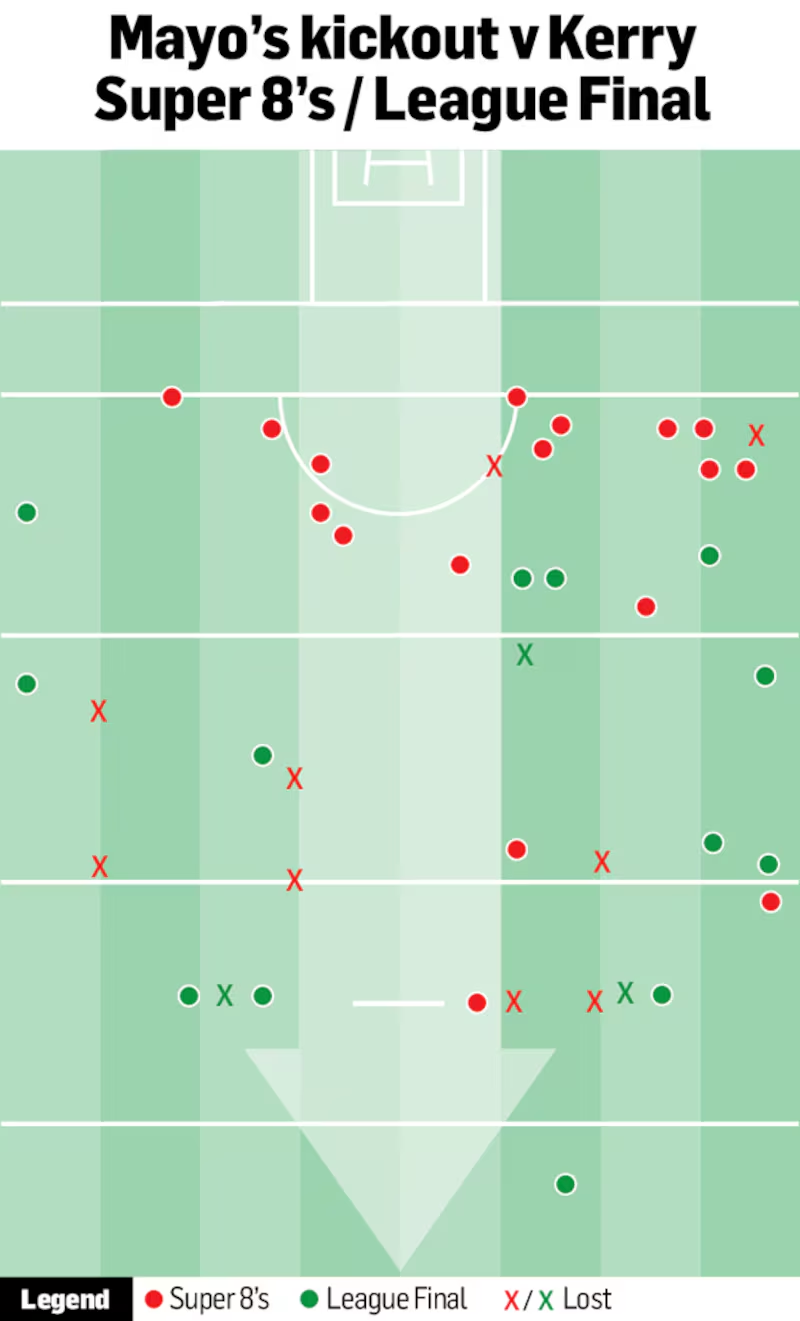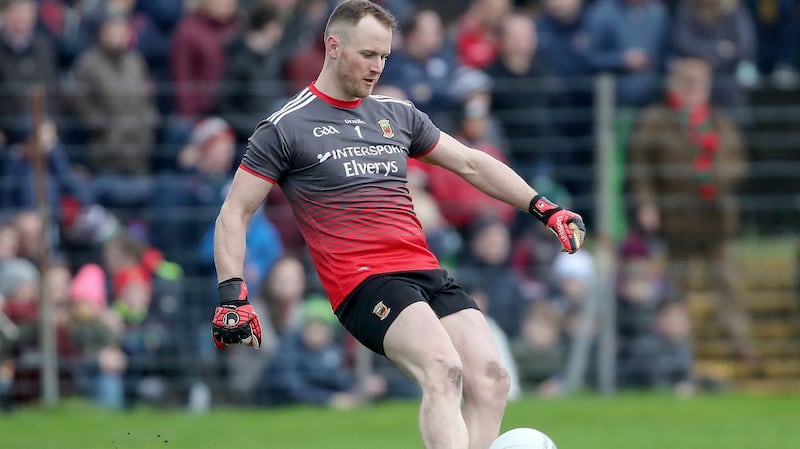Mayo’s kick-out strategy fails to exploit the biggest strengths of either the team or their most important players.
In four of his five championship starts this summer David Clarke has been unable to find Aidan O’Shea for a clean catch from a long kick-out. His only two came in their qualifier win over a Down team who were lacking inches in the middle sector. Big Aidan is the country’s best ball winning midfielder, but he has not been dominating his own team’s restarts as you would expect.
That’s one of the reasons why Mayo have retained only 74 per cent of their own kick-outs so far this summer (not including the New York preliminary round match), and they have not won any more than 78 per cent in any single match. Figures which certainly do not shout All-Ireland contenders.
Another major reason behind the low percentage is that Clarke has kicked 48 per cent of his restarts within the distance of his own defensive D. That means a team who flourish on the front foot are free game to be pushed up on, and made build attacks from their very last line.
And when they lose kick-outs within that crucial scoring zone, or lose a long direction-less kick-out in the middle of the field with numbers committed, they are wide open to conceding. In their last six matches Mayo have conceded 2-15 directly from kick-outs they have failed to retain possession from.
James Horan’s team have been on the back foot for far too long this summer and it’s one of the reasons why they’ve struggled for form. The plan appears to be based on limiting the risk – secure possession as quickly as possible and if there’s no clear option available then go long. But it’s not working.
Their last two matches against Kerry have provided contrasting performances and contrasting results which explain the problem, and suggest a possible solution.

Mayo edged Kerry in the league final in March and, with Rob Hennelly in goal, they retained 81 per cent against Kerry’s organised press. Their three lost kick-outs were all long contests.
The big difference that Hennelly brings however is that all of his short kick-outs went beyond the edge of the D. The Breaffy stopper’s range is further and more ambitious, and when he goes longer the trajectory allows for much more high fielding. He kicked 16 balls in that final and six resulted in marks, two by his club mate O’Shea. He looks to put the ball in front of his man, and he also has the power to go into the opposition’s half which brings half-forwards like Diarmuid O’Connor directly into play.
Mistakes happen
Less than four months later though and Clarke had regained the No 1 jersey as Kerry opened their Super 8s campaign with a convincing win over Mayo. He kicked 13 short kick-outs (from 26) within the distance of his own D. Often to isolated defenders facing their own goal and under pressure.
David Moran targeted his long kick-out – which tends to be quite high and towards a zone rather than aiming for a moving target – and he caused havoc cutting across the field to catch it.
Clarke’s lost kick-outs resulted in 0-5 for Kerry, and he was fortunate to avoid conceding a goal after a number of indecisive moments. Like any goalkeeper asked to kick short, these mistakes happen. But with Mayo players they tend to be blown up further.
Hennelly hasn’t started since the Connacht semi-final defeat to Roscommon. Mayo only won 70 per cent of their kick-outs that day (they won 65 per cent against Kerry in the Super 8s) and from the ones they lost he conceded 1-1. The goal was the result of a misplaced short attempt.
To make amends he made a very good save and found his man for 10 of 11 second-half kick-outs. In hindsight, other than the mistake for the goal, he had a very solid game. Seven of his total of 23 kick-outs were in that mid range between the edge of the D and the 65. Securing possession but setting up an attack while doing so, with a bullet-like ping in front of a Mayo player.
In the 2016 All-Ireland final replay Hennelly was a surprise late addition to the Mayo team, in place of Clarke who would go on to win that year’s All Star award. While the match did not go his or Mayo’s way, the decision highlights the difference in quality between the two goalkeepers’ kick-outs.
Even being the in-form goalkeeper in the country wasn’t enough for Clarke to keep his place when Stephen Rochford decided he was prioritising the restart. Albeit the decision was always doomed due to its last minute nature and the pressure cauldron it created.

Clarke has dealt with every single high ball that’s come in on top of him this summer (as did Hennelly against Roscommon and on seven occasions in the league final), and he has saved a very impressive six out of the 10 shots at his goal in those five matches. He is a top quality goalkeeper and a master of the basics. But in terms of distribution, from play and restarts especially, Hennelly offers a lot more.
If they want their summer to go beyond this weekend Mayo have got to start putting quality ball in front of O’Shea for him to dominate. Not hanging over him for the opposition to easily spoil. They have to take more risks in sending their short kick-outs beyond the edge of the D. Their current system says safe on the label, but it’s still leaking cheap scores and means creating their own is constantly laborious.
And overall they simply need to increase their ball retention ratio - unless they are getting into the 80s in terms of percentage of kickouts won they are leaving themselves too high a mountain to overcome.
At this stage teams know to press Mayo’s restarts, they know they have a good chance at forcing Clarke long, committing numbers to the side he twists his body towards and then winning breaks. Or enacting a full press on a short kickout in a dangerous zone for the Mayo defence. There’s very little fear of a red and green jersey being picked out over the first line of the press, or all of it.
So Horan, like Rochford before him, will have to weigh up how important he considers kick-outs to be. And how ambitious and brave he wants his goalkeepers to get with them. That question may result in another change of personnel, but it’ll certainly need at least a change of approach.
















